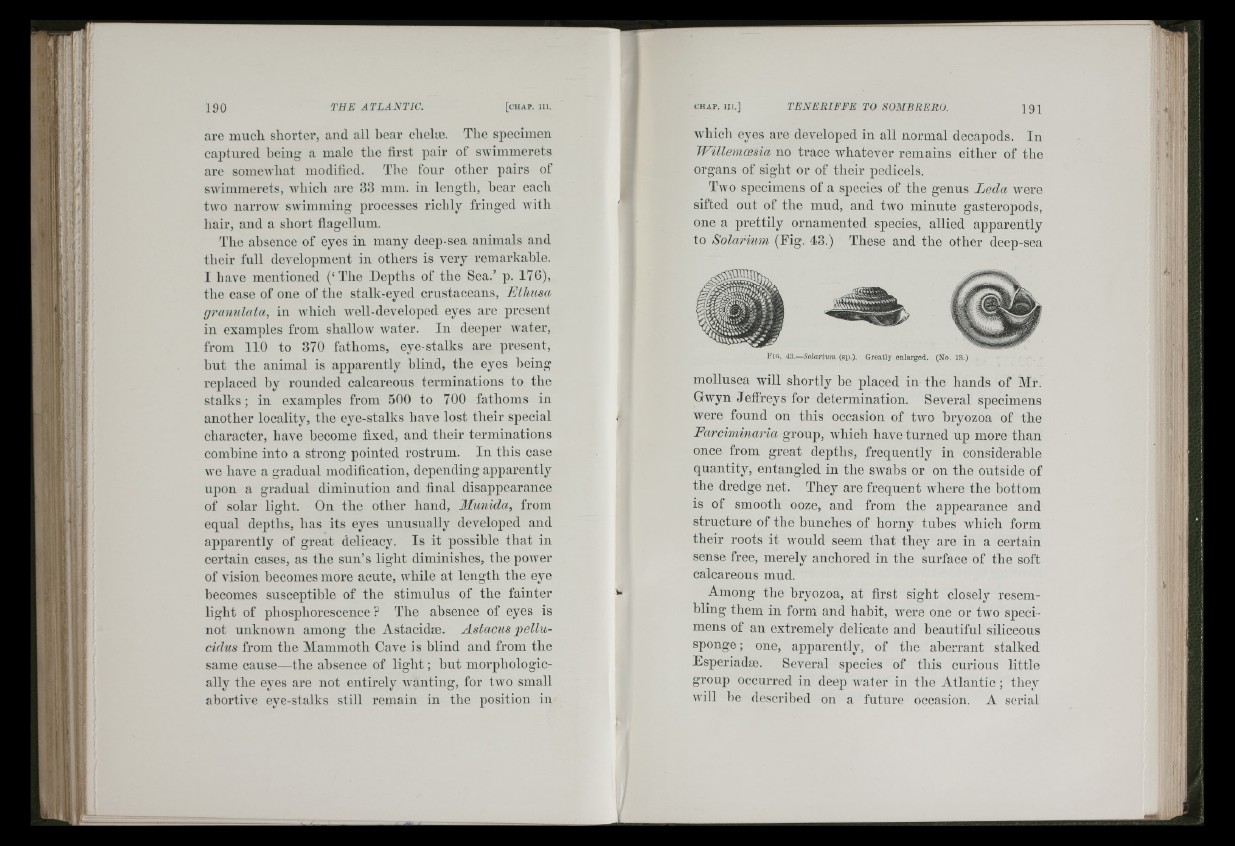
are mueli shorter, and all bear ehelæ. The speeimen
captured being a male the first pair of swimmerets
are somewhat modified. Tlie four other pairs of
swimmerets, Avhich are 33 mm. iu length, hear each
two narrow swimming processes richly fringed with
hair, and a short flagellum.
The absence of eyes iu many deep-sea animals and
their full development in otliers is very remarkable.
I have mentioned (‘The Depths of the Sea.’ p. 176),
the case of one of the stalk-eyed crustaeeans, Ethusa
granulata, in wdiich well-developed eyes are present
in examples from shallow water. In deeper ivater,
from 110 to 370 fathoms, eye-stalks are present,
but the animal is apparently blind, the eyes heing
replaced by rounded calcareous terminations to the
stalks; iu examples from 500 to 700 fathoms iu
another locality, the eye-stalks have lost their special
character, have become fixed, and their terminations
combine into a strong pointed rostrum. In this case
we have a gradual modification, depending apparently
upon a gradual diminution and final disappearance
of solar light. On the other hand, Munida, from
equal depths, has its eyes unusually developed and
apparently of great delicacy. Is it possible that in
certain cases, as the sun’s light diminishes, the poAver
of vision becomes more acute, while at length the eye
becomes susceptible of the stimulus of the fainter
light of phosphorescence ? The absence of eyes is
not uuknoAvn among tbe Astacidæ. Astacus pellu-
cidus from tbe Mammoth Cave is blind and from the
same cause—the absence of light ; hut morphologically
the eyes are not entirely Avanting, for tAvo small
abortiA'e eye-stalks still remain iu the position in
Avhicli eyes are developed in all normal decapods. In
JEillemcesia no trace Avhatever remains either of the
organs of sight or of their pedicels.
Two specimens of a species of the genus Leda Avere
sifted out of the mud, and tAVO minute gasteropods,
one a prettily ornamented species, allied apparently
to Solarium (Fig. 43.) These and the other deep-sea
Fio. 43.— S o la r ium (sp.). Greatly enlarged. (No. 13.)
mollusca will shortly he placed in the hands of Mr.
GAvyn Jefi'reys for determination. Several specimens
were found on this occasion of tAvo hryozoa of the
F a r c im i n a r i a group, Avhich have turned up more than
once from great depths, frequently in considerable
quantity, entangled in the SAvahs or ou the outside of
the dredge net. They are frequent AA'here the hottom
is of smooth ooze, and from the appearance and
structure of the bunches of horny tubes Avhich form
their roots it Avould seem that they are in a certain
sense free, merely anchored in the surface of the soft
calcareous mud.
Among the hryozoa, at first sight closely resembling
them in form and habit, Avere one or tAvo specimens
of an extremely delicate and heautiful siliceous
sponge; one, apparently, of the aberrant stalked
Esperiadse. Several species of this curious little
group occurred in deep AA'ater in the Atlantic ; they
Avill he described on a future occasion. A serial
' itei. j
A'ii